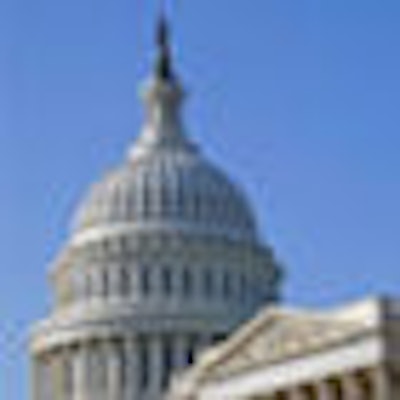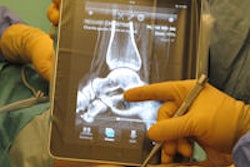
The debate over how best to regulate mobile medical apps reached the halls of the U.S. Congress this week as representatives sparred over a proposed bill that could strip the U.S. Food and Drug Administration of its authority to regulate many types of app software.
While some members of the U.S. House of Representatives spoke on Tuesday in favor of a proposed bill that aims to revamp and codify federal regulation of mobile medical apps, several skeptics expressed concern over the potential impact of key aspects of the draft legislation -- especially given that the FDA unveiled its own plan for app regulation just a few months ago.
The Energy and Commerce Committee's health subcommittee hearing focused on the recently proposed HR 3303, called the Sensible Oversight for Technology Which Advances Regulatory Efficiency (SOFTWARE) Act of 2013. Proponents of the bill testified at the hearing that the health IT industry needs more clarity beyond the FDA's recent final guidance for mobile app regulation, and that a new approach is needed for regulating mobile medical apps.
In contrast, Dr. Jeffrey Shuren, director of the FDA's Center for Devices and Radiological Health (CDRH), said in his testimony that he believed any legislation would be premature, would remove high-risk devices such as radiology computer-aided detection (CAD) software from regulatory oversight, and would actually offer less flexibility to deal with a rapidly changing technology and the marketplace than the agency's current guidance for mobile medical apps.
SOFTWARE Act
The SOFTWARE Act, introduced on October 22 by Rep. Marsha Blackburn (R-TN) with a bipartisan list of co-sponsors, aims to "create regulatory certainty by giving FDA a new tool to regulate some forms of these emerging technologies without regulating them as medical devices."
In its current form, the bill would dramatically reshape the regulation of medical software, including mobile apps. It defines three categories of health IT: medical software, clinical software, and health software, of which only the largely patient-oriented "medical software" category would remain under regulation by the FDA.
Medical software would include software that is intended to directly change structure or any function of the body, or is intended to be marketed for use by consumers and make recommendations for clinical action. Furthermore, medical software is not software whose primary purpose is integral to the functioning of a drug or device and it is not a component of a device, according to the bill.
Clinical software as defined in the proposed bill refers to clinical decision-support software or other software intended for human or animal use that may capture, analyze, or present patient or population clinical data, but that does not directly change the structure or any function of the body. It is intended to be marketed for use only by a healthcare provider in a healthcare setting.
Finally health software is defined as software that is not medical or clinical in nature and whose primary purpose is to act as a platform for secondary software, to run or act as a mechanism for connectivity, or to store data.
No longer regulated
Under the bill, clinical and health software would not be subject to regulation under the Federal Food, Drug, and Cosmetic Act. Instead, the bill advocates the development of a risk-based regulatory framework for such clinical and health software "that reduces regulatory burdens, promotes patient safety, and fosters innovation."
In statements at the hearing, sponsors and supporters of the bill said they believe that health IT and mobile apps should not be regulated as medical devices, as it is an antiquated and ill-fitting model for a new, fast-moving, and valuable technology such as mobile medical apps.
Although not a sponsor of the bill, Health Subcommittee Chairman Rep. Joe Pitts (R-PA) said that patients and industry have told Congress that the FDA's involvement and guidance on mobile apps was a good thing, and that the FDA acted to the best of its ability with the only tool available to it -- its definition of medical devices.
"But they also are telling Congress that we need to give FDA new tools that create regulatory certainty, not just today but also for tomorrow," Pitts said. "That certainty can start with properly defining what these technologies are for the purposes of regulation."
Too soon?
Some at the hearing weren't convinced, however. Rep. Frank Pallone Jr. (D-NJ) expressed concern that the FDA's final guidance on mobile apps was just released in September and there hasn't been an opportunity yet to see how it works in practice or to hear from industry if there are any barriers to innovation.
Also, the Office of the National Coordinator for Health IT (ONC), the Federal Communications Commission (FCC), and the FDA are collaborating to propose strategies and recommendations on a risk-based regulatory framework for health IT, as required by the Food and Drug Administration Safety and Innovation Act (FDASIA). It might be prudent to wait on that report, which is due in January 2014, before moving any legislation, he said.
Legislation may not even be necessary or the right approach, according to Pallone.
"In an environment in which technology is changing so rapidly, I question whether it makes sense to enshrine in a statute something that may not work for an ever-evolving industry," he said.
There might also be concerns down the road of permanently carving out certain types of mobile apps from the FDA's oversight.
Co-sponsor Rep. Gene Green (D-TX) noted that the legislation is a work-in-progress, but added that the FDA has done all it can through enforcement discretion to implement common-sense steps to foster innovation while protecting patient safety.
"Enforcement discretion is not the right tool, but it's all they have," Green said. "It's Congress' obligation to give the FDA the tools necessary to properly protect patient safety and also to encourage innovation and create regulatory uncertainty. That's why the SOFTWARE Act is important."
Outdated definitions
Bill sponsor Blackburn said that the FDA is stuck trying to use a 1970s definition of a medical device to regulate mobile medical apps and other healthcare-related software.
"Trying to funnel these products into existing outdated definitions is just not going to make any sense and it will not work," she said. "The SOFTWARE Act would give the agency a needed tool for emerging technologies when necessary, while allowing moderate to low-risk technology developers the certainty necessary to proceed with development, knowing full well what the regulatory playing field is going to be."
While the FDA took an important step in its final guidance for mobile apps in acknowledging where the focus should be, Congress has the opportunity to go further to ensure that "the innovators have the clarity and certainty they need to continue to invest in this area to develop tools that will make us healthier," Blackburn said.
Rep. Henry Waxman (D-CA), however, said the FDA's guidance on mobile medical apps strikes the right balance between protecting patient safety and promoting innovation. That balance is upset with the current draft of the SOFTWARE Act, he said.
"I think there are several examples of mobile medical apps that we would all agree should not be permanently removed from FDA's oversight, but that's exactly what the current draft does," he said. "I'm not suggesting that this was the intent of the sponsors, but it does illustrate a major concern I have, whether the blunt instrument of legislation is the appropriate tool for regulation of mobile medical apps given the rapidly changing nature of technology in this area."
Once a law is in place, it's very difficult to change it, "and it's exceedingly difficult to craft the perfect legislative language that will preserve FDA's ability to oversee appropriate subsets of these changing technologies now and in the future," Waxman said.
Premature legislation?
In his testimony, FDA's Shuren noted that the agency's September guidance provided clarity to developers of mobile apps regarding which ones were subject to federal oversight and which weren't.
"We are only regulating the small subset of mobile apps that are medical devices," he said. "We have called this subset 'mobile medical apps' and believe that this pragmatic, narrowly tailored approach will promote innovation while protecting patient safety, by focusing on those mobile apps that pose greater risk to patients."
Regulation is based on risk and function -- that is, their intended use. The foundational principle is that devices that perform the same function for a patient are regulated in the same manner, regardless of the platform on which it is used, Shuren said.
The guidance also does not relate to clinical decision-support software, he noted. That technology will be addressed by the ongoing collaborative effort of the ONC, FCC, and FDA to propose a risk-based regulatory framework for health IT.
Shuren noted that the FDA will provide ongoing clarity to mobile app developers through a new website, on which the agency will continuously post new examples of apps it is not regulating. Developers can also email the agency with any questions, he said.
"Smart regulation by the FDA can promote innovation in mobile apps and protect patient safety," Shuren said.
A marked change
When asked during his testimony if the proposed bill codifies the FDA's policy toward mobile apps, Shuren said it does not and would, in fact, remove from the FDA's authority some devices that the agency currently regulates, including some high-risk devices.
By carving out software categories in a new statute, the FDA would be stuck with those definitions and would have to build a framework around them, Shuren said.
"It's unclear at this point if those lines are drawn in the best possible way for the most appropriate regulatory framework that facilitates innovation while also protecting patients," he said.
As defined in the bill, software such as CAD for radiology images would be excluded from regulation, as would radiation therapy planning software, Shuren said.
"If it's inaccurate or we don't ensure it's safe and effective, radiologists may miss cancers or they may send women for inappropriate biopsies," he said. "In radiation therapy planning, which takes patient information and analyzes their imaging studies to come up with what dose of radiation should be given to their cancer ... if that [software] is not safe and effective, then cancer patients don't get the right radiation to their cancer or they get radiation to their healthy tissue."
The value of the guidance process over relying on a statute is that it's more flexible and makes it easier to adjust over time to changing technology, according to Shuren. For example, the practice of enforcement discretion allows the FDA, after gathering more experience and with input from the community, to elect to no longer regulate certain technology.
While sharing the same goals of promoting innovation and protecting patient safety, the FDA wants it to happen properly, he said.
"Moving quickly to judgment leads to unintended consequences that can be very hard to undo once they're done," Shuren said.
While not for or against the legislation, mobile device expert Dr. David Hirschorn of Staten Island University Hospital said he has some concerns about the way the SOFTWARE Act is currently written.
"Because the language of the bill appears to restrict FDA purview to only software that alters the structure or function of the body, software that is used for diagnosis, which is most of what radiologists do, would effectively be excluded from FDA regulation," Hirschorn told AuntMinnie.com. "That raises questions as to how that software will be regulated and how safety and efficacy will be ensured if it's not regulated by the FDA."




















